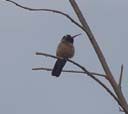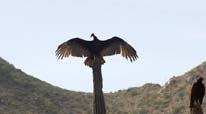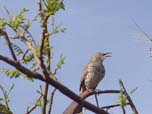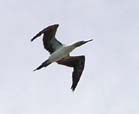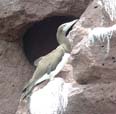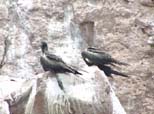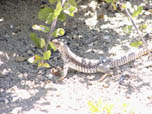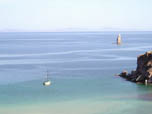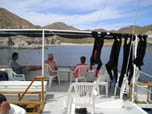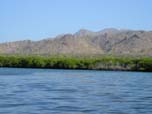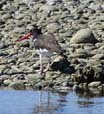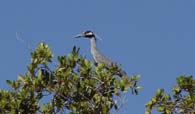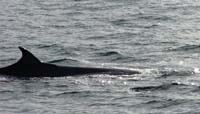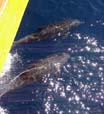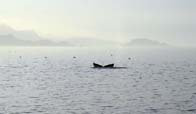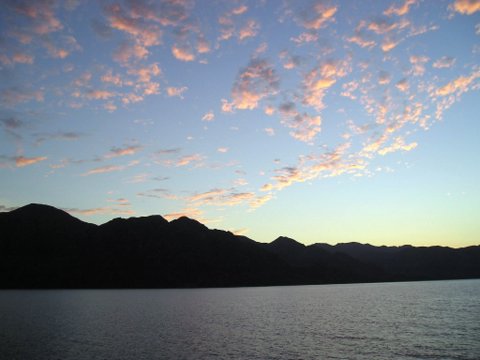Baja California Sur The Cape Region,
Midriff Islands and Sea of Cortez
by Roger Wolfe
Click on photos to see enlarged images.
EAST CAPE
April 16
My wife Laura and I arrived at the airport in Los Cabos late
in the afternoon and met up with a group of our friends with whom
we would be traveling with for the next 10 days. I arranged for a
driver and a van to transport us from the airport to the sleepy village
of Cabo Pulmo on the eastern cape. I spent a fair amount of time here
in the eighties and wanted to return to the place I remembered so
fondly. Back then I wasn't birding and now I was interested in catching
up on some of the avian life that had gone largely unnoticed back
then. This would also give us the opportunity to decompress a couple
of days before our boat trip into the Sea of Cortez.
Cabo Pulmo is about an hour and a half north of the airport and some
of it is along unimproved roads that are a heck of a lot better than
they were in '86. Approaching the village we enjoyed numerous sightings
of NORTHERN CARACARAS. Upon arrival we soon were all settled
into our comfortable bungalows and casitas which were very reasonably
priced and close to the water at Cabo
Pulmo Beach Resort. In the evening we dined on tasty shrimp tacos
under a palapa on the beach watching BROWN PELICANS fish the
shallows.
April 17
At first light the birding begins in earnest. With all
the washingtonia palms about, HOODED ORIOLES are ubiquitous
and their chatter is heard continuously. Leaving the landscaped area
there is a small flock of LARK SPARROWS and the first of many
COMMON GROUND DOVES. Just a short way down the road that heads
south we hit pay dirt with the first endemic of the trip, a male XANTUS'S
HUMMINGBIRD perches obligingly and allows a few digital photos.
Shortly afterwards endemic number two is a GREY THRASHER singing
from the top of a cardon cactus. A large raptor atop another cactus
is a HARRIS'S HAWK.
Cabo Pulmo turns out the birds: NORTHERN CARDINAL, PYRRHULOXIA,
BLACK-HEADED GROSBEAK, WHITE WINGED DOVE, GILA
and LADDER BACKED WOODPECKERS, ASH-THROATED FLYCATCHER,
VERDIN, BLUE-GRAY GNATCATCHER, CALIFORNIA TOWHEE,
TURKEY VULTURE, BROWN HEADED COWBIRD, NORTHERN MOCKINGBIRD
and numerous CACTUS WRENS.
In the afternoon after snorkeling along the fine reef that can be
reached easily from the beach, another short bird walk adds SCOTT'S
ORIOLE, AMERICAN KESTREL and PHAINOPEPLA to the
day's tally. Dinner under the stars at Nancy's is a bit pricey but
well worth it. There we have the best margarita on the trip.
April 18
In the night we are awakened by the wind rustling through the palms.
A walk north along the beach turns up two SPOTTED SANDPIPERS
as well as two endemic YELLOW-FOOTED GULLS. Just before noon
the van arrives to take us to La Paz where the boat we will call home
for the next 6 days is docked. Our route is Highway 1 along the east
cape and mountain towns. We arrive in La Paz and board the 80-foot
Don Jose. A stiff wind from the north nags at us through the evening.
THE SEA OF CORTEZ and MIDRIFF ISLANDS
April 19
Our crew of 6 arrives this morning and by 8 am we are
underway. The wind from the north has not abated and once we get out
of the La Paz harbor the swell picks up. A few onboard suffer the
effects of seasickness despite the Relief Bands they've purchased
for the trip. We begin seeing seabirds. MAGNIFICENT FRIGATEBIRDS
are abundant and BLUE-FOOTED BOOBIES become prevalent as we
approach the islet of Isla Isolotes. As we close in on the islet we
also begin seeing numerous BROWN BOOBIES both perched and in
flight.
We pile into the pangas (skiffs) and take a spin around.
The big draw to Los Isolotes are the CALIFORNIA SEA LIONS that like
to haul out here. They allow us up close looks as do the seabirds.
In the midst of the small colony is a single BLACK TURNSTONE.
Afterwards some of us don our snorkeling gear and kick out along the
rocks. The sea lions come in alarmingly close, startling some of us
back to the boat. It is a pleasure to see them underwater in their
element. The wind hasn't helped with the visibility but we do see
some very cool fish. At one point I look up at the birds on the rocks
and see several VAUX'S SWIFTS dart overhead.
In search of a protected anchorage we head north into the teeth of
the wind to the blown out caldera which comprises Isla San Francisco.
We settle for the night in the small crescent shaped bay out of the
wind and swell. We hit the shore much to the delight of the seasick.
Fortunately for all on board this is the last time anyone gets seasick.
Our cook Enrique impresses all on board his first of many wonderful
dinners. My wife Laura and I sleep out on the top deck under a sky
brimming with stars. The wash of the Milky Way is incredible.
April 20
After breakfast some of us swim to shore, others kayak or ride the
pangas in to explore the tiny island of San Francisco. Along the inside
curve of the island is sandy beach and a few hundred yard across a
salt flat on the other side are rocky beach and seacliffs. The greeting
committee is comprised of a single AMERICAN OYSTERCATCHER looking
a bit out of place on the sandy beach. Here we also find a LEAST
SANDPIPER all by his lonesome.
Hiking along the ridge of the island we find many BLACK-THROATED
SPARROWS, a COSTA'S HUMMINGBIRD, COMMON RAVENS and
more YELLOW-FOOTED GULLS who appear to be nesting and disturbed
over the ravens' presence. At the end of the hike we return to the
beach to find an ice chest filled with cold beverages. The crew of
the Don Jose know how to take care of their guests.
After lunch we depart our anchorage and find that the devil of a north
wind is still blowing but not quite as bad. Approaching the Canal
de San Jose, a passage between the large Isla San Jose and the mainland,
we see many BLACK and LEAST STORM-PETRELS, our first
HEERMAN'S GULL and a single RED-BILLED TROPICBIRD. I'm
up in the crow's nest above the upper deck feeling like the king of
the world when someone calls out whale. We see the telltale fluke
of a HUMPBACK WHALE. As I search for the whale to resurface I spot
a large bird arc in the wind. I am somewhat surprised to find a LAYSAN
ALBATROSS this far north in the Sea of Cortez. Later I ask Captain
Jose about these birds and he says he sees one or two a year. They
sometimes check out the boat and the crew will toss them a tortilla
or two and they will settle on the water to eat them.
In the late afternoon we anchor off Isla San Jose. On the shoreline
we spy a GREAT BLUE HERON perched atop a giant cardon cactus
and enjoy a walk up an arroyo to some narrows. Along the way we see
XANTUS'S HUMMINGBIRD, VERDIN, BLACK-THROATED SPARROWS,
ASH-THROATED FLYCATCHERS, a Burro and our first RED-TAILED
HAWK of the trip. Walking back down the arroyo into the setting
sun I find myself overwhelmed by the beauty of this place and tears
roll down my cheeks as we ride the pangas back with the sun setting
beyond the boat. I realize what John Steinbeck was getting at when
he described the "miraculous air" of this place in The Log from
the Sea of Cortez.
Dinner is breaded, fried scallops. This has easily been one of the
finest days of my life.
April 21
Just before dawn the engine starts up and we are underway. We've got
a fair amount of traveling to do today. The sense of remoteness begins
to settle in. If you look at a map of Baja California you will see
that this area in which we are traveling is inaccessible by land.
This is a roadless coastline and the islands are with few exceptions
uninhabited. We see only an occasional sailboat or yacht and primitive
fish camps along the way.
Our destination this morning is Isla Catalina. This island
is known for its gigantism. The Midriff Islands are often referred
to as the Mexican Galapagos. Endemic plants that are unique to individual
islands sometime comprise as much as two thirds of the plant species
and many of them remain unidentified. Enroute we are visited briefly
by a few BOTTLENOSE DOLPHINS and LONG-BEAKED COMMON DOLPHINS of the
Baja neritic form. Arriving at Catalina we take the pangas in and
hike among the gigantic cardon and barrel cacti. We spot a DESERT
IGUANA and find an unidentified species of rattlesnake on the side
of the trail. Birds seen here are a WILLET on the beach, a
LOGGERHEAD SHRIKE atop a giant cardon, ASH-THROATED FLYCATCHER,
VERDIN and BLACK-THROATED SPARROWS which are abundant
on all the islands it seems.
We spend the rest of the morning snorkeling or kayaking around the
island and shortly after lunch we depart. Our destination is the small
fishing village of Agua Verde on the mainland. This small community
of 200 can be reached via a 25 mile long unimproved road from Highway
1. Approaching the mainland we see more storm-petrels and 2 spouts
with a telltale fluke. A mother and calf HUMPBACK WHALE appear quite
close to the boat much to the delight of all on board. Here we also
find a fair sized pod of LONG-BEAKED COMMON DOLPHIN who come in to
ride our bow for excellent up close looks in clear waters. There is
a lot of feeding activity going on that is joined by a group of bull
CALIFORNIA SEA LIONS. Perhaps most impressive are the numbers of BROWN
PELICANS that continue arriving in squadrons until there are several
hundred around the boat. We find our only shearwater of the trip in
the midst of all this activity, a very full BLACK-VENTED SHEARWATER
can scarcely lift itself off the water as we approach. ELEGANT
TERNS finally put in an appearance.
We arrive at Agua Verde after dark after enjoying another brilliant
sunset.
April 22
The sunrise upstages the sunset from the previous evening. A panga
ride into shore and we visit the small fishing village of Agua Verde.
The village goats and cattle parade by us and we are greeted by the
waves of school children. A VERMILLION FLYCATCHER sallies from
the thorn scrub. We walk up over a ridge above the village to secluded
beach. Here we find an OSPREY on the sand and see its nest
atop a rock in the small bay. NORTHERN CARDINALS and ASH-THROATED
FLYCATCHERS call from the bush. On the rocks nearby we see both
BRANDT'S and DOUBLE CRESTED CORMORANTS. SNOWY
and GREAT EGRETS fish the shallows.
Ague Verde will be our northernmost stop, we have traveled about 125
miles from La Paz and now its time to begin our return. We head south
keeping close to the mainland to avoid a stiff breeze from the south.
Many of those on board have had the pleasure of rafting the Grand
Canyon and all proclaim this scenery very similar to the lower reaches
of the canyon but with only one wall to view. This remote coastline
must surely be one of the most spectacular on the planet.
Down the coast to Puerto Gato we see numerous BLACK and LEAST
STORM-PETRELS. We stop here to swim, snorkel and kayak. On the
beach we can see and occasionally smell a dead whale at the water's
edge. It's too far gone to identify to species. As I kick in to shore
I swim over pieces of blubber and whale skeleton. This is a whale
graveyard. On the beach is the lower jaw of what must be a Blue Whale
and there are also two large spinal columns on the beach. But the
smell is overwhelming. I get back into the water and enjoy some good
snorkeling around the point to another nearby beach.
The Don Jose heads south. Our goal for the evening is the southern
end of Isla San Jose. On the way we spot some blows near the mainland.
I'm crossing my fingers in hopes of seeing a new cetacean and I'm
not disappointed. The three rostral ridges indicates we've come upon
a pair of BRYDE'S WHALES. These baleen whales don't migrate so in
order to see them you have to venture into their tropical and subtropical
waters. As the day draws toward sunset we come upon a huge group of
LONG-BEAKED COMMON DOLPHINS. This group is comprised of more than
a thousand animals some of which are accompanied by small youngsters
that look to be only days old. From the bow we watch them ride our
wave. Arrival at the south end of San Jose is after dark.
April 23
This morning we board the pangas to visit a new ecosystem. Into the
mouth of the estuary with some tricky maneuvering at low tide we begin
to explore the mangroves of Isla San Jose. I explain to our panga
driver in Spanish that I'm looking for a small yellow bird with a
reddish brown head and he smiles and says, "Mangrove Warbler." As
we make our way into some narrow channel we hear its call. A bit of
pishing and there he is, a resplendent, male MANGROVE WARBLER.
Presently considered conspecific with Yellow Warbler it certainly
looks quite different and to my ear sounds different too.
I can't get over the contrast of the mangroves with a backdrop of
thornscrub and tall cardon cactus. In an area of saltflats we see
new trip birds: REDDISH EGRET, WHITE IBIS and 3 WHIMBRELS.
In the mangroves we find a GREEN HERON lurking among the exposed
roots and atop another shrub is a picturesque YELLOW-CROWNED NIGHT
HERON. On a pebbly beach we find 7 WILSON'S PLOVERS and
a single AMERICAN OYSTERCATCHER and a flock of hungry TURKEY
VULTURES feeding on the carcass of a sea lion. We leave the pangas
and find this stretch of shoreline to be an excellent place for shelling.
Back on board the Don Jose we continue our southbound return. On
the approach to the Espiritu Santo island complex we find more whales
feeding. This time it is a mixed group of both BRYDE'S and HUMPBACK
WHALES. We also are lucky to be visited by a very friendly pod of
BOTTLENOSE DOLPHIN that ride the bow and turn on their sides to give
us eyeball to eyeball looks. At one point I wave at them and this
seems to interest them for several of them turn on their side to get
a better look. This is truly one of the highlights for many on board,
this interaction with the dolphins. Soon after this we also see a
giant MANTA RAY leap from the surface and a SABINE' S GULL
lands on the water beside the boat.
We stop to snorkel at Los Isolotes and then stop for the night at
nearby Isla Partida. The sound of splashes all around us are of Mobulus
Mantas doing flips in the air. Our cook Enrique really outdoes himself
on our last night with a fine meal of camarones (prawns).
April 24
At first light I hear the distinctive song of a CANYON WREN
from the rocks nearby. We motor a short distance to the larger Isla
Espiritu Santo. This island has many aqua colored inlets with sandy
beaches. Some of us kayak and others ride the pangas into shore. In
the cove three ROYAL TERNS fish for the plentiful sardines
we can see from the surface.
Up canyon we hike past a salt flat alive with small Fiddler Crabs
into the desert silence which is broken only by the call of a soaring
RED-TAILED HAWK. A ROCK WREN here is new for the trip.
This is also the only time on the islands that we see the Antelope
Squirrel. This is a lovely, red rock canyon with some large fig trees
growing in it. Two Chuckwallas sun themselves at the rim of the canyon
above us. With heavy hearts we return to the boat for a short swim
before heading back to La Paz.
Back to the marina we bid our fantastic crew adieu and board taxis
for the short ride up the malecon to the Hotel Los Arcos. Very comfortable.
Dinner is at Rancho Viejo, an excellent carne asada, street food kind
of place.
April 25, 26
Laura and I rent a car from National and head south for Todos Santos,
another favored hang out from the eighties. My how things have changed.
Much of the town businesses-restaurants, galleries, tourist shops
(which didn't used to be here) are run by gringos. We stayed at the
very comfortable and reasonably priced Posada del Molino two blocks
down form the Pemex service station on Rangel. LESSER NIGHTHAWKS
plied the evening skies. On the morning of the 26th I birded an agricultural
area behind the baseball stadium just down the street. The area was
quite birdy but the only new species I found here for the trip were
WHITE-CROWNED SPARROWS. A brief visit to the estuary next to
Posada La Poza turned out AMERICAN COOTS, RUDDY DUCKS,
SAVANNAH SPARROW and a WESTERN GREBE.
We drive to San Jose del Cabo for the night but haven't enough time
to bird the estero or nearby sewage facility. Lodging is at the very
comfortable and well priced El Encanto Inn downtown. Baan Thai restaurant
is across the street, excellent Thai food with some Mexican influence.
Notes: We chartered the 80-foot Don
Jose from Baja Expeditons
and were very pleased with the quality of the service, food and naturalist
John Conlon.
Learn about the next Sea of Cortez
trip scheduled for April 2005.
Roger Wolfe for Monterey
Seabirds
